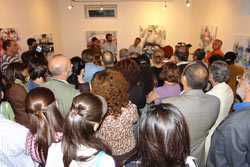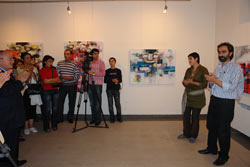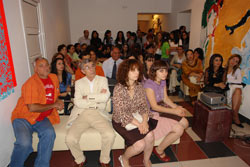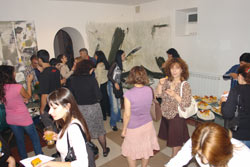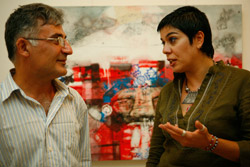

"Absence of God means He is no longer visible, He who would directly gather around Him and to Him people and things and from within this gathering would set down the world history and inside it the human abode. But absence of God proclaims something graver. Not only gods and God have fallen but the divine splendor of human history went. The world night-time is meager as everything goes meager. It is so poor that it fails to see God's absence." M. Heidegger Sanctity is the presence of divinity, and eternity. In contrast to it comes "ordinariness", simplicity. The art-critic doesn't normally overlook sacral and profane, divine and mundane themes. Zara Manucharyan does the same. The Spanish art-critic Gerardo Fontanes Perez compared her with Ariadne. The present world is tangled and confused. The art-critic tries to undo this knob tries to find the thread clutching to which we find the way of peaceful coexistence in this world, the way out of the labyrinth, the door which in itself is art. Paraphrasing this thought we can say that Zara's main art theme was the world night and the indigence of the world era. Indigence is profane; absence of sacral is absence of God. Ugliness is the poorness of aesthetics. The more rooted and noticeable is God's absence the more ugly becomes the human reflection in art.
Zara's tour to the East, to Nepal , this spring was pre-thought as "embrace" - widening of horizon, a road to learn. Western mentality is "embracive" while Eastern is "proceeding". It demands walking forward step by step. Every step is a ring in the chain connected with the joined force, the name of which could be Dao, Mahayana or the wheel of Fate, Karma. Every being has its ancestor that is it exists because there exists the Line coming from its ancestors. This line deviates into "depths" and "ups" The tourist's road is "even" but as fate has willed she went to "Bodhisattva", as she put it, to light and illumination, deviated from the tourist route and went up to transcendental. She met a youth, Ram Bahadur Benjani, who was striving for the highest degree of illumination. She saw Hindu and Buddhist temples, believers and monks who have already been living an eternity on ancient and sacred traditions. These meetings became the subject of her film "The Road to Bodhisattva". The film first of all depicts and compares two lines: horizontal "flat" and vertical "sacral". This changed her artistic outlook . The spirit of her paintings is totally new and transformed. If the spirit of her previous works was the "night of civilization", now the spirit of brightness, meditation and pray dominate. Seeing real but not formal traditions changed her style of presentation. In this series she comes to the transcendental through symbolism (J. Mariten) and the desire to impart the presence of spiritual illumination. Zara's canvases speak about divine prophesy, and sacral phenomena. From the compositional point of view two layers can be singled out in these paintings. The background reveals the conventional silhouettes of Buddhist temples and monks. They seem unreal, emerging from the mist, the faces of monks are strict like their ascetic way of life. They transmit the Bodhisattva of sacred places and saints. On the foreground are Indian and Buddhist symbols, mandalas, fragments from prayers, suttas, in Sanskrit. The Russian philosopher and poet Ivanov considers that the language of art, according to the definition, is religious - symbolic. A human spirit communicates with the transcendental world through symbols. In this case works a well - known formula: art is another expression of prayer. This layer is iconoclastic; it needs spiritual vision, as Patanjali puts it, "spiritual reading". "Spiritual reading" can be understood as meditation. The mystery of these painting can be deciphered comparing them with mandalas. Mandala is created right for prayers and meditation. It reminds a labyrinth from the first sight but has an opposite function. In difference to labyrinth its line is vertical, it doesn't confuse but moves from outer darkness into inner light. Mandala watches both inside and outside. Symbols differ from signs in that they carry super meaning, they concentrate in themselves divine, natural and human interlink. In Zara's paintings they carry the mission of saving the soul from the dark outer chaos. The painter put her ego to the change and to the making in the light arc of darkness so that the upper being becomes her cradle. This is the change that brings a painting and icon together, makes it a gap for the upper being. The prayer gives art its esoteric function. Through new artistic means Zara recoded the religious into aesthetics, tried to open up the link between cultures, between past and present. Taking into consideration art-aesthetic universal forms, her own intuition of the sacral, she created symbol art, which is capable of taking the imagination and mind out of semantic labyrinth to the spiritual depth. But it doesn't bring human mind to the final point, doesn't bring out mysteries of mind. The aesthetic value of human mind is in its inexplicability. Vardan Jaloyan Art Critic |
